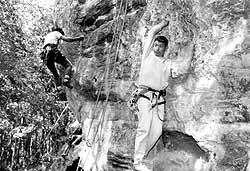 There's plenty more to adventure sport than meets the eye. And you get to see that dangling from one finger off a sheer rock face, or inching through a crack in a wall that seems too small for anything more than a fern.
There's plenty more to adventure sport than meets the eye. And you get to see that dangling from one finger off a sheer rock face, or inching through a crack in a wall that seems too small for anything more than a fern. Rock climbing is perhaps one of the least promoted and under recognised sports in Nepal. But though Nepal has a long way to go before it can compete with other Asian climbing countries such as Japan, the Philippines and Indonesia, some rock faces have been developed as training grounds for enthusiastic climbers, both local and foreign.
The Nepal Mountaineering Association (NMA) and other private parties have been instrumental in promoting rock climbing, and slowly, the sport is entering public consciousness. The NMA has been providing training in rock climbing for the last six years to school and college students, and officials say the response is improving, particularly after the association started publicising the training program and providing more information on the sport.
The training program is held twice a year for a minimum of 15 amateur Nepali climbers. The NMA annually trains about thirty people at Nagarjun in Kathmandu and Chiwong in Solu Phaplu, a high altitude region. Climbing is an adventure sport in its own right, but it is also a necessity for those who want to receive training in mountaineering.
Since 1998, Eco Himal and the NMA have also been jointly organising mountaineering training courses in Thame, Solu Khumbu. The five-week courses include rock climbing. The two organisations last week also held a refresher course at Nagarjuna for alumni of the Mountaineering School in Thame.
ang Norbu Sherpa, a climbing expert associated with Mountaineering School in Thame, says a lot needs to be done to create awareness about rock climbing. Adventure sport enthusiasts come to Nepal to go mountaineering, trekking and rafting, but you never hear of anyone who comes here to go rock climbing. Aang Norbu is convinced that if the sport were pushed by tourism authorities and private adventure tour operators, we would see a substantial number of tourists increasing their stay by a day or two.
In contemplating the possibilities of rock climbing in Nepal, the discussion often turns to Indonesia. While most of us think of the archipelago as superb diving country, among professionals Indonesia is slowly gaining a reputation for good climbing, particularly through its indoor competitions. Outdoor rock climbing is mostly around Jakarta or nearby Bandung, but Sumatra has some pretty spectacular outdoor climbing cliffs. This sort of adventure sport branding, say people like Aang Norbu, would be easy to do in Nepal
The NMA does have rock climbing experts such as Ang Nuru Sherpa, Prem Bahadur Gurung, Lhakpa Norbu Sherpa, Kilu Temba Sherpa, Iman Singh Gurung and Da Gombu Sherpa. All of them were trained at the Ecole Nationale de Ski et d'Alpinisme in France and could play an important part in popularising the sport. But along with that, we also need to improve training facilites through, among other endeavours, building indoor walls like the one the Pasang Lhamu Foundation is building near Maharajgunj.
Anyone up for a climb?
Climbing the Valley's rock faces
 Kathmandu offers some terrific places for those who like inching up sheer vertical cliffs with their fingernails.
Kathmandu offers some terrific places for those who like inching up sheer vertical cliffs with their fingernails. Few people know that you can go climbing in the Royal Park of Nagarjuna near Balaju, a 20-minute walk north-west of Kathmandu. For a Rs 10 entrance fee, beginners and experts can have their pick of several cliffs within the park. The best one is about three km inside, from the entrance walk up the road that leads to the army checkpoint, just before the post, there is a track leading off the right which in five minutes gets you to a 10-12 m granite face. There are several piton equipment routes up this of varying degrees of difficulty.
The other interesting, though less explored, climbing site in the Valley lies north of Kathmandu on the slopes of Shivapuri adjacent to the Bishnumati river. The cliffs here are black granite, and need more effort, if not more expertise. To get here, head west past Budhanilkantha school and climb up along the left bank of the Bishnumati. The track passes through paddy fields before entering the Shivapuri Wildlife Reserve, where the cliffs are.


